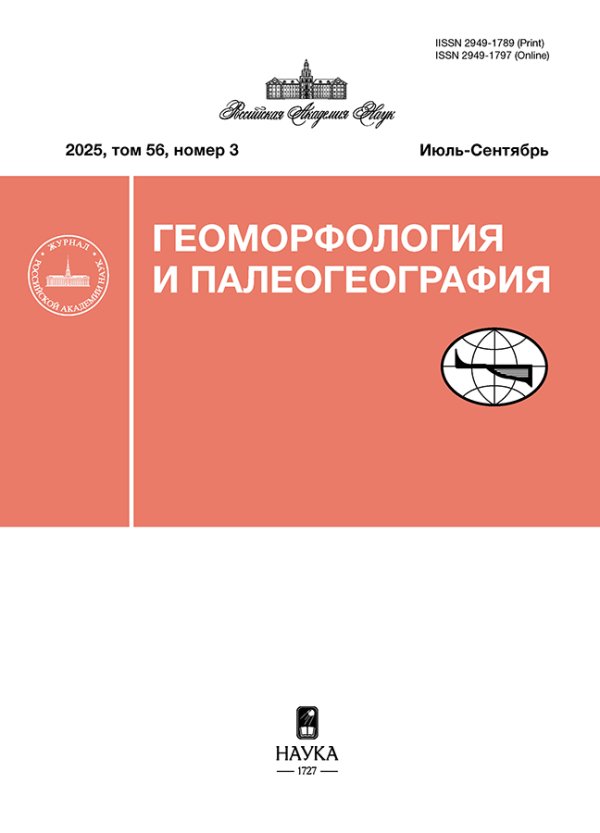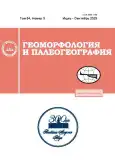ON THE ISSUE OF THE AGE OF THE UPPER PLATEAU SURFACE OF THE MIDDLE VOLGA REGION (EUROPEAN RUSSIA)1
- Authors: Petrova E.V.1, Gusarov A.V.1
-
Affiliations:
- Kazan Federal University
- Issue: Vol 54, No 3 (2023)
- Pages: 39-48
- Section: SHORT COMMUNICATIONS
- URL: https://journals.rcsi.science/2949-1789/article/view/140582
- DOI: https://doi.org/10.31857/S2949178923030076
- EDN: https://elibrary.ru/WDHMVR
- ID: 140582
Cite item
Full Text
Abstract
The Middle Volga region is an area of layer-tiered and stepped uplands, in which the upper plateau is the most ancient surviving (among the known) element of the relief of this region of the East European Plain. The plateau is located within the highest interfluves at the prevailing elevations of 280–380 m, representing the upper level of the relief. Most researchers support the denudation (pediplanation) nature of its origin. The age of formation of the plateau surface is still a matter of debate. In this paper, based on literature sources, the author’s ideas about the development of the Neogene valleys of the paleo-Volga and its tributaries, an analysis of changes in the geomorphological, paleoclimatic and paleolandscape conditions of the Middle Volga region and neighboring regions was presented. It is concluded that the most optimal time for the pediplanation of the region’s relief and, consequently, the formation of the surface of the upper plateau was the time period between the time boundary of the Middle and Late Miocene (Sarmatian?) and the middle of the Maeotis (Late Miocene), which was distinguished by relative tectonic stability and general increase of climate aridization.
About the authors
E. V. Petrova
Kazan Federal University
Author for correspondence.
Email: helengeo@mail.ru
Russia, Kazan
A. V. Gusarov
Kazan Federal University
Email: helengeo@mail.ru
Russia, Kazan
References
- Ananova E.N. (1971). On the age of the Kinel Formation (according to palynological data). Stratigrafiya neogena vostoka Evropeiskoi chasti SSSR (Stratigraphy of the Neogene of the east of the European part of the USSR). Moscow: Nedra (Publ.). P. 86–97. (in Russ.)
- Bludorova E.A., Nikolaeva K.V. (1986). Geologicheskaya i palinologicheskaya kharakteristika pliotsenovykh otlozhenii Kazanskogo Povolzh’ya i Prikam’ya (Geological and palynological characteristics of the Pliocene deposits of the Kazan Volga and Kama regions). Kazan: Kazan University (Publ.). 136 p. (in Russ.)
- Brylev V.A., Dedova I.S. (2015). On the development of sandy verhnemaykopskiy sediments in the Volga-Don interfluve and characteristics of neotectonic stage. Proceedings of Voronezh State University. Series: Geology. No. 2. P. 19–25. (in Russ.)
- Butakov G.P., Dedkov A.P. (1971). Analiticheskoe izuchenie krupnooblomochnogo materiala (Analytical study of coarse-grained material). Kazan: Kazan University (Publ.). 81 p. (in Russ.)
- Dedkov A.P. (1970). Ekzogennoe rel’efoobrazovanie v Kazansko-Ul’yanovskom Privolzh’e (Exogenous relief formation in the Kazan-Ulyanovsk Cis-Volga region). Kazan: Kazan University (Publ.). 255 p. (in Russ.)
- Dedkov A.P. (1972). On denudation sections and ancient planation surfaces in the Middle Volga region. Ekzogennye protsessy v Srednem Povolzh’e (Exogenous processes in the Middle Volga region). Kazan: Kazan University (Publ.). P. 3–20. (in Russ.)
- Dedkov A.P. (1993). The upper plateau of the East European Plain. Geomorfologiya. No. 4. P. 82–89. (in Russ.)
- Dedkov A.P. (2003). Neotectonics and geomorphology. Geologiya Tatarstana. Stratigrafiya i tektonika (Geology of Tatarstan. Stratigraphy and tectonics). Moscow: Geos (Publ.). P. 337–364. (in Russ.)
- Dedkov A.P., Mozzherin V.I., Stupishin A.V., Trofimov A.M. (1977). Klimaticheskaya geomorfologiya denudatsionnykh ravnin (Climatic geomorphology of denudation plains). Kazan: Kazan University (Publ.). 224 p. (in Russ.)
- Dedkov A.P., Mozzherin V.V. (2003). Eopleistocene. Geologiya Tatarstana. Stratigrafiya i tektonika (Geology of Tatarstan. Stratigraphy and tectonics). Moscow: GEOS (Publ.). P. 242–248. (in Russ.)
- Gerasimov I.P., Aseyev A.A. (Eds.). (1986). Morfostruktura i morfoskul’ptura platformennykh ravnin SSSR i dna omyvayushchikh ego morei (Morphostructure and morphosculpture of the platform plains of the USSR and the bottom of the surrounding seas). Moscow: Nauka (Publ.). 190 p. (in Russ.)
- Gorelov S.K. (1974). On the problem of complex analysis of planation surfaces and weathering crusts. Geomorfologiya. No. 1. P. 15–26. (in Russ.) https://doi.org/10.15356/0435-4281-1974-1-15-26
- Gorelov S.K., Drenov N.V., Mescheriakov Yu.A. et al. (1970). Surfaces of planation of the USSR. Geomorfologiya. No. 1. 28–41. (in Russ.) https://doi.org/10.15356/0435-4281-1970-1-28-41
- Goretsky G.I. (1964). Allyuvii velikikh antropogennykh prarek Russkoi ravniny (Alluvium of the Great Anthropogenic Pro-Rivers of the Russian Plain). Moscow: Nauka (Publ.). 414 p. (in Russ.)
- Iosifova Yu.I., Agadzhanyan A.K., Semenov V.V. (2004). Regional stratigraphic scheme of the Neogene and Eopleistocene deposits of the Paleo-Don. Regional Interdepartmental Stratigraphic Commission for the Center and South of the Russian Platform. Moscow. (in Russ.)
- Jahn A. (1956). Wyżyna Lubelska. Rzeżba i czwartorzęd (Lublin Upland. Sculpture and Quaternary) (Prace Geograficzne, IG PAN, Nr 7). Warszawa: Państwow e wydawnictw o naukowe (Publ.). 460 p. (in Pol.)
- Lebedev L.I., Aleksina I.A., Kulakov L.S. et al. (Eds.). (1987). Kaspiiskoe more. Geologiya i neftegazonosnost' (Caspian Sea. Geology and oil and gas potential). Moscow: Nauka (Publ.). 316 p. (in Russ.)
- Linkina L.I., Petrova E.V. (2015). Climatic and landscape conditions in the Middle Volga region at the turn of Miocene and Pliocene. Uchenye Zapiski Kazanskogo Universiteta. Seriya Estestvennye Nauki. Vol. 157. Issue 1. P. 34–48. (in Russ.)
- Mazarovich A.N. (1927). From the field of geomorphology and history of the relief of the Lower Volga region. Zemlevedeniye. Vol. 29. Issue 3–4. P. 21–42. (in Russ.)
- Meshcheryakov Yu.A. (1960). Morfostruktura ravninno-platformennykh oblastei (Morphostructure of plain-platform areas). Moscow: USSR Academy of Sciences (Publ.). 112 p. (in Russ.)
- Meshcheryakov Yu.A. (1965). Strukturnaya geomorfologiya ravninnykh stran (Structural geomorphology of the plain areas). Moscow: Nauka (Publ.). 390 p. (in Russ.)
- Milanovsky E.V. (1940). Ocherk geologii Srednego i Nizhnego Povolzh’ya (Essay on the geology of the Middle and Lower Volga regions). Moscow–Leningrad: Gostoptekhizdat (Publ.). 276 p. (in Russ.)
- Nevesskaya L.A., Kovalenko E.I., Beluzhenko E.V. et al. (2005). Regional stratigraphic scheme of the Neogene, Southern European part of Russia. Otechestvennaya Geologiya. No. 4. P. 47–60. (in Russ.)
- Oreshkina T.V., Aleksandrova G.N. (2017). Paleocene–lower Eocene paleontological record of the Ulyanovsk-Syzran facial district, Volga-Peri-Caspian region. Stratigraphy and Geological Correlation. Vol. 25. Issue 3. P. 73–98. https://doi.org/10.1134/S0869593817030066
- Petrova E.V. (2008). The arrangement regularities of Neogenic river valleys on the Tatarstan Republic territory and their correlation with modern river network. Uchenye Zapiski Kazanskogo Universiteta. Seriya Estestvennye Nauki. Vol. 150. Issue 4. P. 43–50. (in Russ.)
- Piotrovsky M.V. (1945). To the study of the main features of the relief of the Lower Volga region. Izvestiya Akad. Nauk SSSR. Seriya Geograficheskaya i Geofizicheskaya. No. 2. P. 311–314. (in Russ.)
- Popov S.V., Antipov M.P., Kurina E.E. et al. (2010). Sea-level fluctuations on the northern shelf of the eastern Paratethys in the Oligocene-Neogene. Stratigraphy and Geological Correlation. Vol. 18. Issue 2. P. 99–124. https://doi.org/10.1134/S0869593810020073
- Puchkov V.N. (2010). Geologiya Urala i Priural’ya (aktual’nye voprosy stratigrafii, tektoniki, geodinamiki i metallogenii) (The geology of the Urals and Cis-Urals (actual problems of stratigraphy, tectonics, geodynamics and metallogeny)). Ufa: DesignPoligraphService (Publ.). 280 p. (in Russ.)
- Rozhdestvensky A.P. (1971). Noveishaya tektonika i razvitie rel’efa Yuzhnogo Priural’ya (Recent tectonics and development of the relief of the Southern Urals). Moscow: Nauka (Publ.). 303 p. (in Russ.)
- Shpul V.G. (2011). Climatic optimum on the territory of Oka-Don Plain in the Middle Miocene (according to palynological data). Proceedings of Voronezh State University. Series: Geology. No 2. P. 264–266. (in Russ.)
- Velichko A.A. (Ed.). (1999). Izmenenie klimata i landshaftov za poslednie 65 millionov let: (Kainozoi: ot paleotsena do golotsena) (Changes in climate and landscapes over the past 65 million years: (Cenozoic: Paleocene to Holocene)). Moscow: GEOS (Publ.). 260 p. (in Russ.)
- Voitovich E.D. (2003). Sedimentary cover tectonics. Geologiya Tatarstana. Stratigrafiya i tektonika (Geology of Tatarstan. Stratigraphy and tectonics). Moscow: GEOS (Publ.). P. 313–336. (in Russ.)
- Yakhimovich V.L. (1971). Stages of development of the Bashkir Cis-Urals in the Neogene. Stratigrafiya neogena vostoka Evropeiskoi chasti SSSR (Stratigraphy of the Neogene of the east of the European part of the USSR). Moscow: Nedra (Publ.). P. 45–64. (in Russ.)
- Zastrozhnov A.S. (2009). Neogen paleo-Dona: stratigrafiya i istoriya geologicheskogo razvitiya (The Neogene of the paleo-Don: stratigraphy and history of geological development). PhD thesis. St. Petersburg. 24 p. (in Russ.)
- Zhidovinov N.Ya., Kurlaev V.I. (1971). Pliocene deposits of the Northern Peri-Caspian region. Stratigrafiya neogena vostoka Evropeiskoi chasti SSSR (Stratigraphy of the Neogene of the east of the European part of the USSR). Moscow: Nedra (Publ.). P. 169–179. (in Russ.)
- Zhidovinov N.Ya., Zastrozhnov S.I. (2017). Neogene of the Volga-Khoper interfluve. Volga and Pricaspian region resources. Geology. No. 91. P. 49–65. (in Russ.)
Supplementary files











